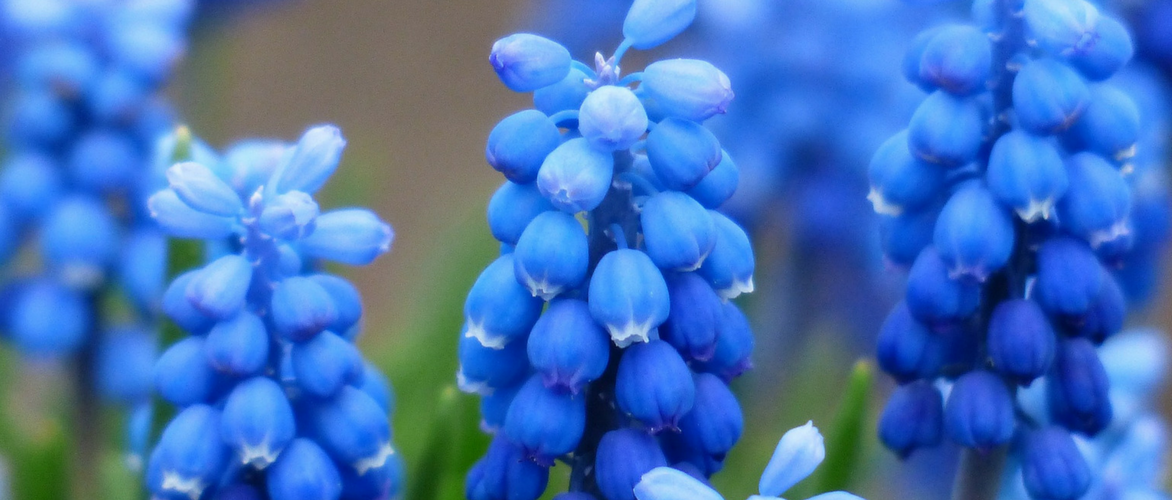
Muscari: planting, growing tips and care
Contents
Muscari in a nutshell
- In spring, its intense blue or white flowers are essential in the garden
- It tolerates both full sun and partial shade
- Low maintenance and very hardy, Muscari offers great resistance to cold (-25°C)
- It naturalises very quickly
- It can be grown in pots as well as in large flowering tapetum
A word from our expert
The Muscari, also known as grape hyacinth, is a lovely little spring bulb, easy to care for, perfectly hardy and grows anywhere with no maintenance required. A sign of spring’s arrival, its clusters of intense blue or white flowers bloom from March to May and are essential in any garden. From the classic Muscari armeniacum or Armenian grape hyacinth to Muscari aucheri White Magic, M. botryoïdes, and bicoloured flowered muscaris like Muscari neglectum or the curious Muscari comosum, Muscari comosum, this must-have for gardens without gardeners thrives equally well in full sun or shade. Planted in well-drained soil, it naturalises easily, forming over the years, very floriferous carpets and beautiful foregrounds in spring.
You can never plant enough of these inexpensive little spring bulbs that can fit anywhere, whether in pots or borders, in large naturalised carpets, in woodland at the foot of trees, or in rockeries, scattered in the short grass meadow or even in Japanese-style gardens or more minimalist designs. This prolific bulb has a knack for adding a touch of freshness and highlighting all the other spring bulbs alongside which it thrives, such as daffodils, jonquils, wood anemones, hyacinths, tulips…
Discover our collection of Muscari ranging from sky blue to pure white, including pale pink, in small or very large sizes to create beautiful spring planters or to flower the garden from the very first year of cultivation.
Botany
Botanical data
- Latin name Muscari
- Family Hyacinthaceae
- Common name grape hyacinth, muscari grape, cluster hyacinth
- Flowering From March to May
- Height 0.15 to 0.60 cm
- Sun exposure Sun, Partial shade
- Soil type All
- Hardiness down to -25°C
The Muscari, also known as grape hyacinth, is a plant from the family Hyacinthaceae / Liliaceae. This small bulbous perennial native to the mountains of south-eastern Europe, Armenia, as well as Turkey and the Caucasus, grows naturally at the edge of woods or on rocky slopes at altitude.
From its mountainous origins, the Muscari has retained a beautiful hardiness. Capable of enduring severe frosts, it acclimatises everywhere and withstands, in our regions, temperatures of down to -25 °C, depending on the species. Beneath its graceful appearance, it is a robust plant that, in addition to this great resistance to cold, tolerates drought and shade well.
The genus comprises 30 species of bulbous perennials, including the classic Muscari armeniacum or Armenian muscari, Muscari aucheri (or Tubergenianum), botryoides, Muscari azureum with shorter foliage than that of other muscari species, some muscari with bicoloured flowers such as Muscari latifolium, Muscari neglectum and Muscari macrocarpum and the curious tufted muscari (Muscari comosum or ‘Plumosum).
Muscari displays a clump-forming habit that is more or less erect depending on the species, reaching heights of up to 60 cm, with a spread of about 30 cm for the most imposing varieties. In two to three seasons, the central bulb initially planted produces bulbils that spread slowly but surely. Once well established in well-drained soil, it will flower for a good ten years, provided the bulbs are divided every 3-4 years to ensure the plant’s longevity. Very prolific, as long as it is not disturbed too much, the Muscari naturalises easily at the foot of deciduous hedges, in borders and in lightly mown meadows. Muscaris also self-seed spontaneously, forming, in a few years, flowering and fragrant carpets.
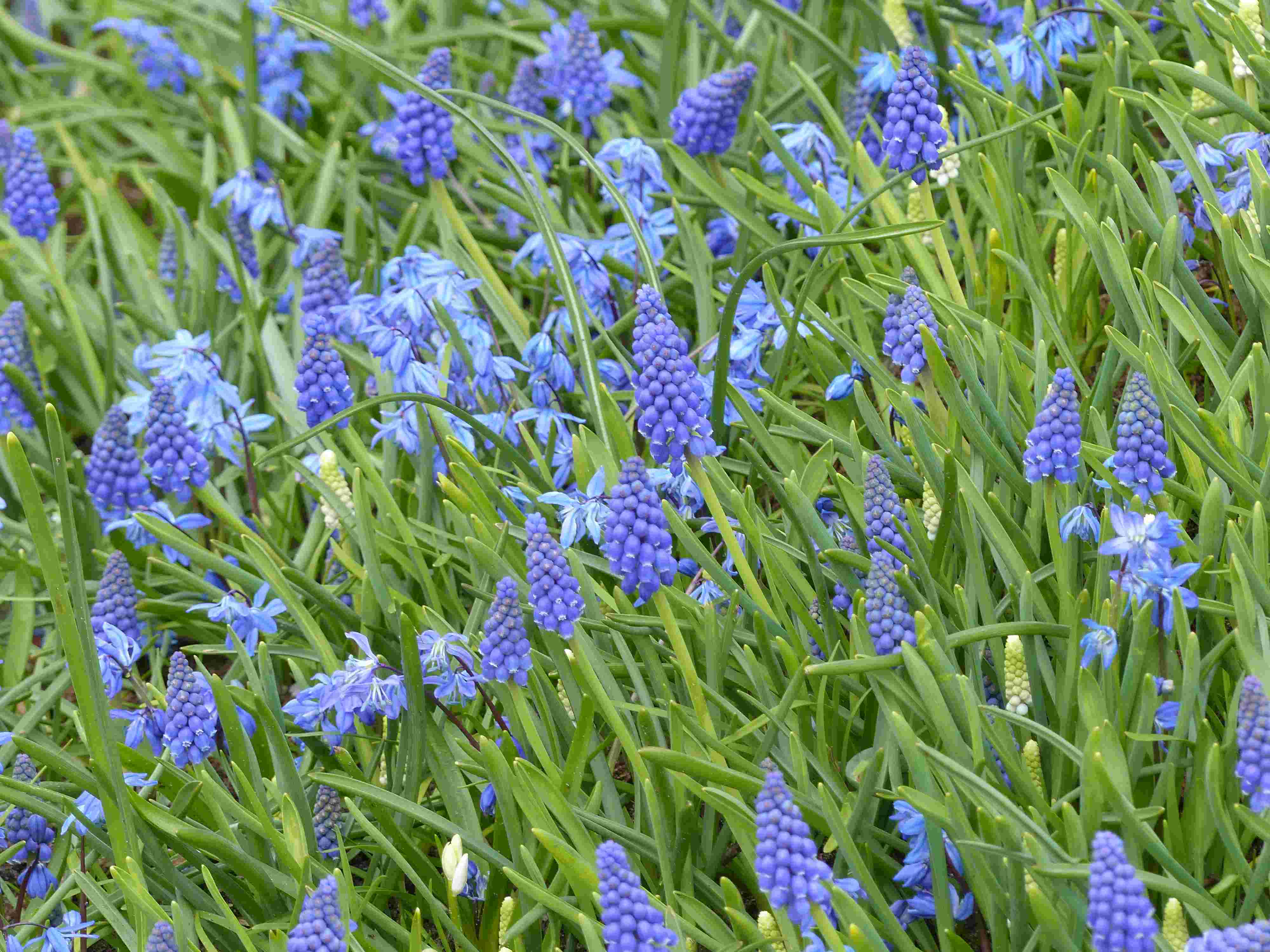
Muscaris also self-seed spontaneously, forming, in a few years, flowering and fragrant carpets
From the first days of spring, the Muscari displays its bright flowering resembling a miniature hyacinth. It forms waves of sky blue or pure white carried by clumps of fresh green grass. When the bulb is mature and well-developed, after two years, each rosette emits in spring 3 to 5 well-erect and graceful flower spikes, ranging from 10 to 60 cm in height. For several weeks, from March to May, these bare stems, devoid of leaves, bear 20 to 40 small drooping flowers gathered in non-toxic terminal conical inflorescences. Clusters of flowers measuring ten to thirty centimetres in height and up to 5 cm wide for the very large calibres. Tightly packed like grapes, the tepals of each bell measure only a few millimetres in length and form a small bell with a mouth often constricted. The appearance of the inflorescences varies according to the species and varieties. The Muscari armeniacum ‘Blue Spike’, a spectacular variety, features very double flowers attached to a plump spike resembling a hyacinth. The Muscari comosum ‘Plumosum’ has the particularity of bearing feathery lilac inflorescences composed of purple filaments, while the species type presents spikes composed of small bell-shaped flowers topped with a small feathery tuft made up of ultramarine to violet filaments. Muscari ‘Mountain Lady’ features original sky-blue flowers topped with a small tuft of white flowers.
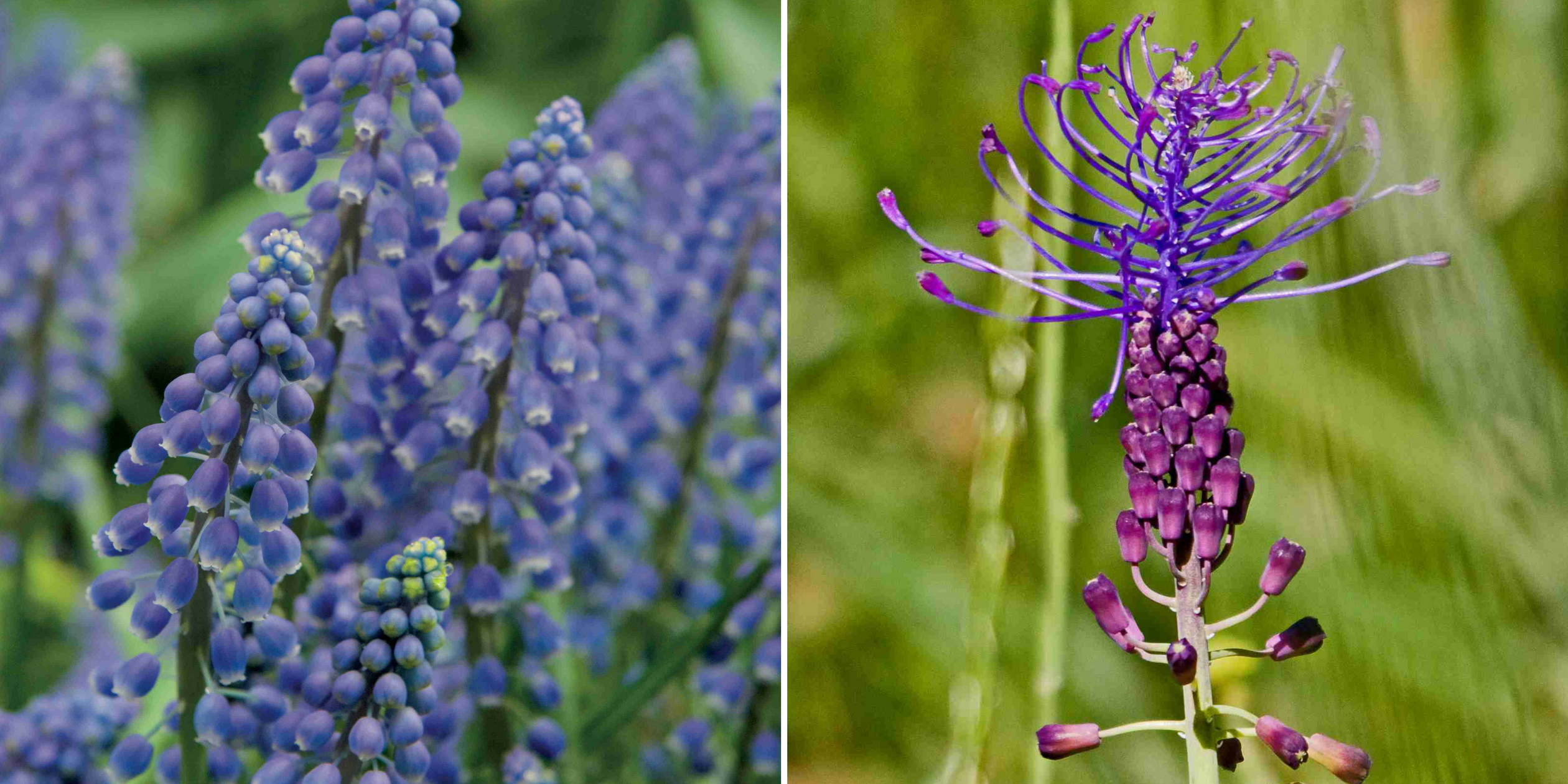
Muscari armeniacum and Muscari comosum ‘Plumosum’ with feathery inflorescences
These small flowers, which are mostly intense blue, bright blue, sky, cobalt or violet, can sometimes be white or pale pink, an unusual colour for a muscari. The Muscari derives its Latin name from musk, the sometimes very intense and heady fragrance emitted by most Muscari flowers, M. Aucheri ‘White Magic’ being one of the most fragrant. These intensely azure, powder pink or pure white cones also make charming little fresh bouquets.
Muscari neglectum and Muscari azureum bear bicoloured bells striped or marginate with bluish white. In others, it is the clusters that are bicoloured: those of Muscari macrocarpum change from purplish brown in bud to lemon yellow at maturity, Muscari latifolium features a crown of flowers with a more intense colour than those at the top of the spike, which are sterile. Only the flowers at the bottom produce seeds. Heavily visited by pollinating insects, after pollination, the faded flowers produce trigonous fruits that release tiny black seeds that self-seed very easily.
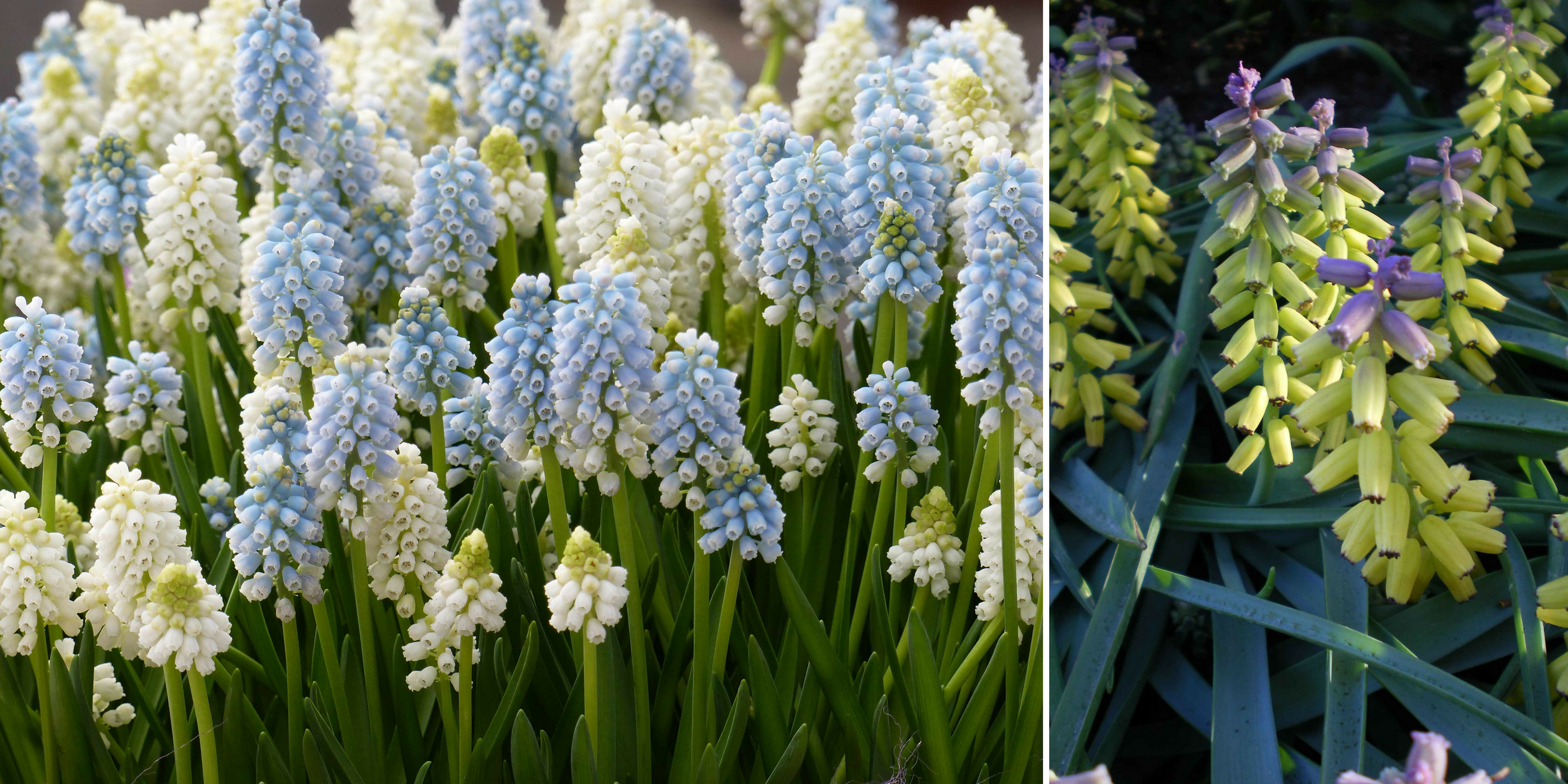
Some varieties like Muscari ‘Ocean Magic’ offer magnificent shades of blue, Muscari macrocarpum striking contrasts
In Muscari, the foliage generally appears before the inflorescence: its vegetative cycle begins at the end of summer, with a few leaves appearing and persisting throughout winter. At the beginning of spring, other leaves emerge from a green basal rosette, and then the foliage develops alongside the flowering. Ranging from 6 to 30 cm long, fleshy, narrow, linear, often bent in the middle or spatulate, they resemble those of snowdrops or are finer and more elongated like those of Muscari neglectum, reminiscent of grasses. Light green to grey-green, they are sometimes shorter than the stem and form a nest of greenery on which the often intensely coloured flower spikes stand out. In summer, the leaves turn yellow, and the plant enters a period of dormancy. Deciduous, the foliage disappears after flowering to return in autumn.

Only Muscari latifolium features a single wide and fleshy leaf of a pruinose green that curls at the base
Very easy to grow, very accommodating, the Muscari grows everywhere and multiplies quickly in all sufficiently fertile, fresh and well-drained soils. While it prefers sunny exposures, it will also flower in partial shade. It can even be planted in woodland as it flowers before the foliage of deciduous trees appears.
Discreet and versatile, the Muscari thrives in many situations and creates scenes of great delicacy or flourishes in the semi-wild corners of the garden. It flowers in all areas of the garden, including balconies. For a beautiful decorative and spectacular effect, plant Muscari in masses, in groups of about ten bulbs, in flowering carpets, in woodland at the foot of trees, in border paths, in rockeries or in scree gardens, scattered in lightly mown meadows or even in Japanese gardens.
The small Muscari bulbs fit anywhere between already established plants, without disturbing perennials and other bushes as they disappear underground when these latter come into growth. This bulbous plant thrives alongside many other spring bulbs, daffodils, jonquils, anemones, hyacinths that its bright flowering will highlight. Early pink or white tulips are also good companions for its graceful flowering. Muscaris can also be combined with each other to create oceans of blue flowers. All Muscaris are suitable for cultivation in spring planters mixed with pansies, daffodils, crocuses, hyacinths or primroses.
Species and varieties
On compte essentiellement une dizaine d’species cultivées dans nos jardins dont the Muscari armeniacum or Armenian muscari which is the most common. We also find white muscaris aucheri (or Tubergenianum) and Muscaris botryoïdes, Muscari azureum with shorter foliage than that of other species, a few species with bicolour flowers like Muscari latifolium, Muscari neglectum and Muscari macrocarpum. And, the curious tufted muscari, Muscari comosum (or ‘Plumosum’).
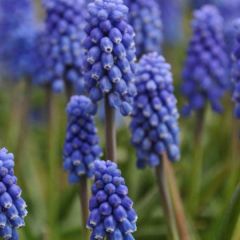
Muscari armeniacum Dark Eyes - Grape Hyacinth
- Flowering time April, May
- Height at maturity 20 cm
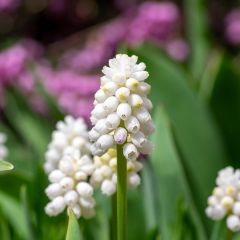
Muscari aucheri White Magic - Grape Hyacinth
- Flowering time May, June
- Height at maturity 20 cm
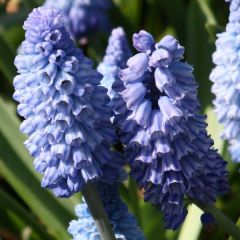
Muscari azureum - Grape Hyacinth
- Flowering time May, June
- Height at maturity 15 cm
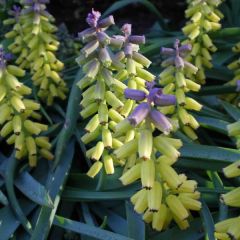
Muscari macrocarpum Golden Fragrance
- Flowering time May
- Height at maturity 15 cm
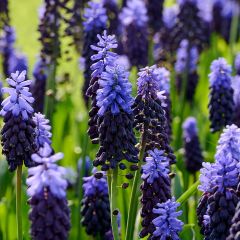
Muscari latifolium - Grape Hyacinth
- Flowering time May, June
- Height at maturity 30 cm
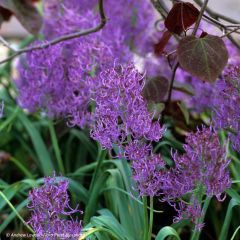
Muscari comosum Plumosum - Grape Hyacinth
- Flowering time May, June
- Height at maturity 15 cm
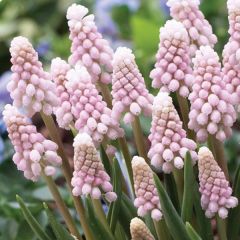
Muscari Pink Sunrise - Grape Hyacinth
- Flowering time May, June
- Height at maturity 15 cm
Discover other Muscari
View all →Available in 0 sizes
Available in 1 sizes
Available in 1 sizes
Available in 1 sizes
Available in 1 sizes
Available in 1 sizes
Available in 0 sizes
Available in 0 sizes
Available in 1 sizes
Available in 1 sizes
Young plantation
When to Plant Muscaris?
These small bulbs are planted early in the season, from September to mid-November, both in the ground and in pots.
Where to Plant These Flower Bulbs?
Muscaris are not demanding regarding soil type and exposure and are perfectly hardy in all regions. They quickly form flowering carpets without ever being invasive. They fit in anywhere, between existing plants, and will fill gaps in two or three years, provided they are allowed to spread naturally.
They can be planted in full sun or partial shade, in ordinary soil, fairly fertile, cool but especially well-drained: they do not appreciate excess water. Muscari armeniacum tolerates even dry soils in summer, while others like Muscaris botryoides thrive in clay soils. The Muscari macrocarpum needs summer warmth to bloom well. Moderately hardy (-7°C), in regions with harsh winters, mulch the soil or store the bulbs; other species can remain in the ground.
Some, like M. armeniacum, display wilted foliage when flowering arrives, forming a somewhat neglected carpet that can easily be masked by planting among Erythrones, wood Anemones, Pulmonarias, or Euphorbias.
Versatile, Muscaris integrate into all settings in woodlands, at the foot of trees, along pathways, in rockeries, scattered in a meadow or a short grass meadow. All muscaris can create beautiful flowering pots.
How to Plant Muscari?
Plant generously, Muscaris are planted in masses (they are economical) and closely for maximum effect, in well-drained soil to prevent bulb rot.
- Loosen the soil deeply
- Improve drainage if necessary with a mix of gravel and soil or laid as a bed under the bulbs
- Plant at a depth of 10 cm, point of the bulb facing upwards
- Space bulbs 8 cm apart or plant in groups of ten in clusters, ensuring they do not touch
- Cover bulbs with twice the height of soil
- Water moderately
- After 2 years, divide the clumps and replant the bulbils from the initially planted bulbs (this will extend the covered area and promote flower vigour)
Pot Culture
Like hyacinths, Muscari bulbs can easily be forced in the cold from autumn, to enjoy their flowering and fragrance indoors. For outdoor use, on the terrace or balcony, prefer a sunny location and larger calibres with bigger flowers. You can also plant them in pots in the year of purchase and then transfer them to the ground.
- Spread a layer of clay balls at the bottom of the pot for perfect drainage
- Fill the pot with a mix of garden soil, potting soil, and pumice
- Plant closely (about ten bulbs per pot) and cover with twice the height of soil
- Water regularly in winter and autumn, then space out in summer to completely stop watering during the dormancy period

Maintenance and care
Muscari is an easy plant that is so accommodating it requires no watering unless grown in a pot, nor any special care. When the foliage turns yellow in summer, after 3-4 years, it is time to lift the bulbs and separate the bulblets to maintain good vigour. No pruning is necessary; however, if you want to control propagation by limiting spontaneous sowing, cut the flower stems after flowering. On the other hand, only cut the foliage when it has faded, to allow the bulb time to replenish its reserves during the summer dormancy period. Muscari bulbs are frost-resistant and can remain in the ground from one year to the next, quickly forming very floriferous carpets. In regions with harsh winters, prefer pot planting for less hardy species such as Muscari macrocarpum or lift and winter the bulbs in a frost-free place. In autumn, you may add decomposed compost by scratching it into the soil at the base of the plants; this will help the bulbs to flower well the following spring.
In pots:
- Water regularly
- Apply special bulb fertiliser until the end of flowering
Possible diseases
Planted in suitable conditions, Muscari shows excellent resistance to diseases. However, keep an eye out for aphid attacks, which can sometimes cause certain viroses that discolour the foliage and flowers. In this case, simply dig up and remove the affected bulbs.
Multiplication
Sowing
The germination of Muscari seeds is long and unpredictable, especially since a young plant from sowing will take several years to flower and Muscari readily self-seed. We recommend division, which is very simple to do.
Division
After two years of cultivation, you can divide the clumps and separate the bulbets. Do this in June and until early autumn when the leaves turn yellow.
- Dig up the clump with a fork
- Separate the bulbs by hand or with a small knife
- Replant the muscari immediately
- Water a little
→ Also discover how to multiply bulbs by scaling in our tutorial!
Associate
Versatile, Muscari is very easy to combine and pairs well with a multitude of low-maintenance plants. Bright yet subtle, it thrives in natural-inspired gardens without gardeners or weekend gardens. Planted in numbers, this small bulb creates maximum impact and forms carpets of blue, white, or even pink flowers in the garden in spring, and beautiful foregrounds in borders.
With its bright flowering, Muscari enjoys many situations as a flowering carpet, at the edge of woodlands at the foot of trees, scattered in the short grass meadow, to dress a path border or a sunny rockery or even in Japanese-style gardens. This radiant bulbous plant flourishes alongside other spring bulbs, Anemone sylvestris, Hyacinths, Ipheions, Iris reticulata, Erythrones. Pulmonarias and Euphorbias will look stunning paired with these small spring bulbs.
Muscari forms magnificent carpets against a backdrop of Daffodils, Jonquils, and early Tulips, in a contrasting blue/yellow-green version or in fresh white/blue scenes imbued with delicacy. Paired together, they create fantastic blue tides at the heart of spring. All are suitable for pot cultivation on a windowsill or balcony mixed with Pansies, small Daffodils, Crocuses, Myosotis, or primroses.
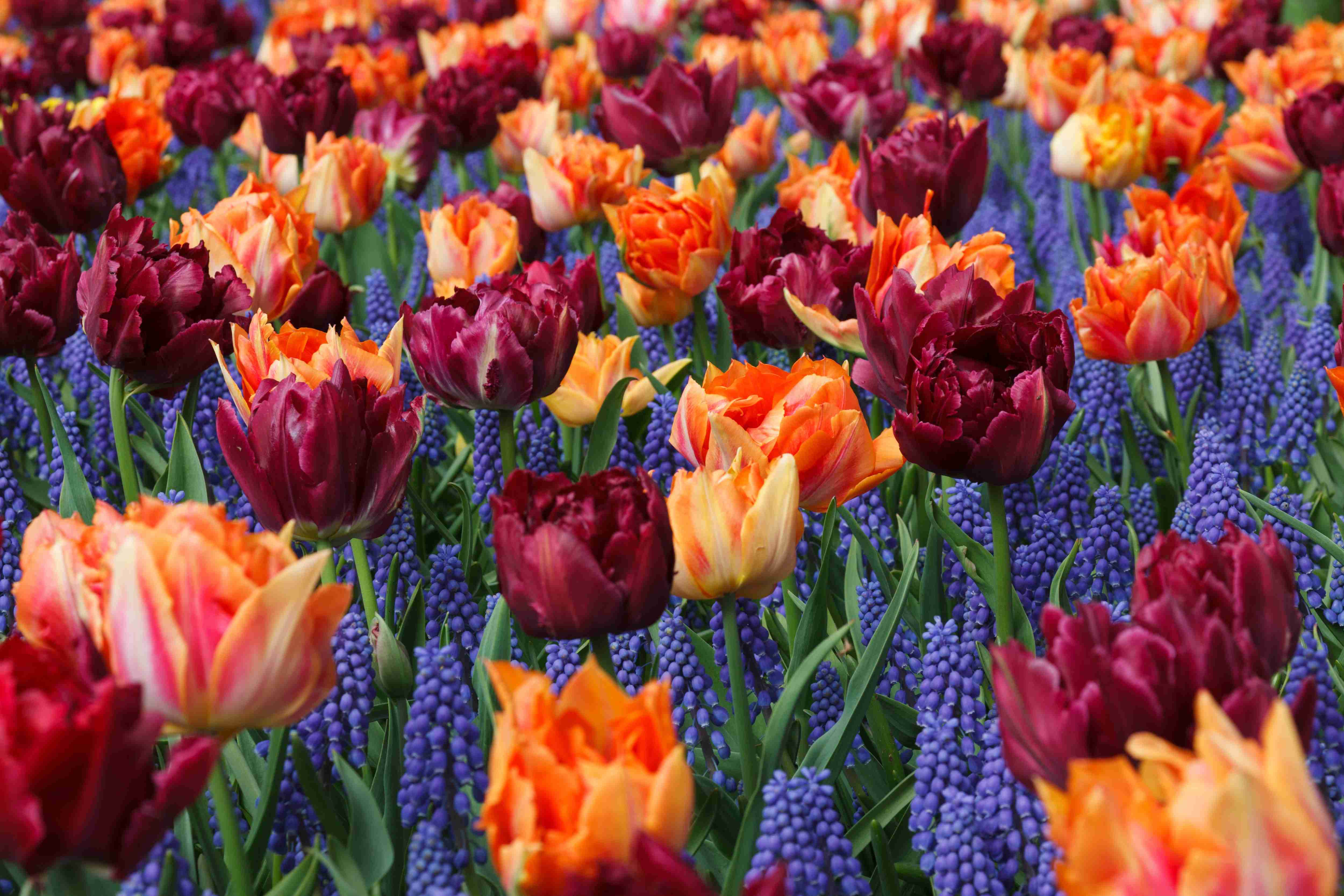
Want even more inspiration? Discover our advice sheet: “Muscari: 8 beautiful pairing ideas”
Useful resources
- Find our advice sheet on how to grow Muscaris in pots
- Our Depth Guide for spring bulbs
- Advice sheet: Which bulbs to grow indoors?
- Advice sheet: Bulb size: understanding to make better choices
- Advice sheet: 6 bulbs to naturalise in the garden
- Discover our video on Muscari armeniacum
- Our advice sheet: 9 blue flowering bulbs to have in your garden
Frequently asked questions
-
Why is my muscari turning yellow?
In summer, Muscari enters dormancy, a period known as "summer dormancy." This is a necessary time for the plant to store reserves for the following spring. Even if you find that the yellowing leaves create an unsightly tapetum, only cut the foliage when it has completely withered, allowing the bulb time to replenish its reserves.
- Subscribe!
- Contents































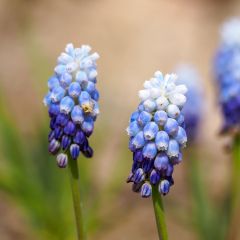
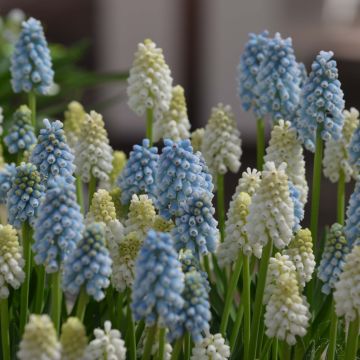
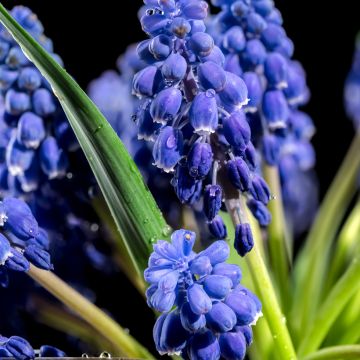

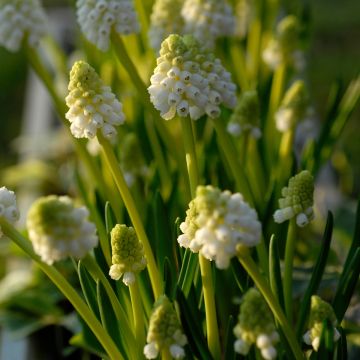
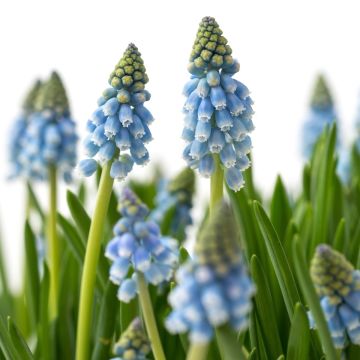
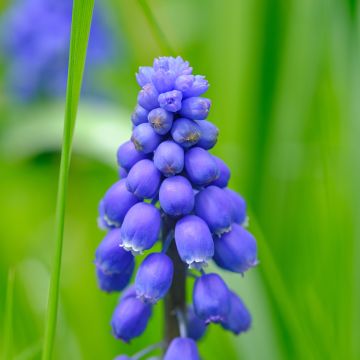
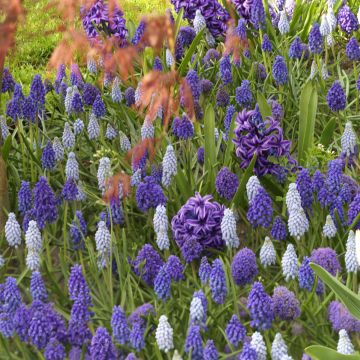

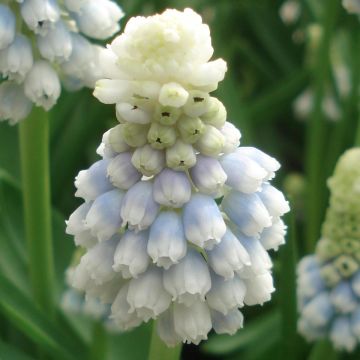

Comments